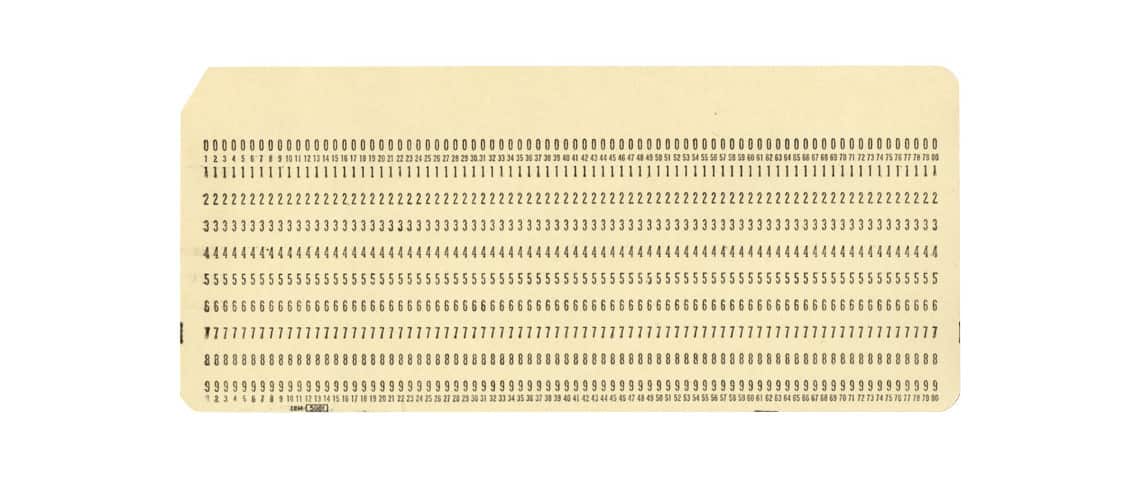In this blog post, we present Part III of our Odd and Awesome Computer Facts series! Read on to gain some fascinating knowledge on the strange history of computing. Why do you need to know these random facts? To help you win trivia night at the pub, of course!
Programming with… punch cards?
Back in the early days of computing, there were no keyboards, no screens, and no development software. Programmers had to write code using punch cards.
One line of code = one card
Each card represented a single line of a program. Writing a full program often required hundreds—or even thousands—of cards. The holes punched into the cards represented instructions the computer could read.
To fix even a small error, a new card had to be punched and used to replace the incorrect one. No copy-paste, no undo button!
A slow and meticulous process
Once the program was complete, the cards had to be fed into an IBM card reader. They had to be placed in the exact right order—no exceptions. Only then could the computer process the instructions.
One of the programmers’ worst nightmares? Dropping a stack of punch cards on the floor. Putting them back in order could take hours. Even worse, some cards might get lost or damaged, meaning they’d have to be reordered and repunched.
A bygone—but fascinating—era
Punch cards were used well into the 1970s. They powered some of the first programming languages like Fortran, COBOL, and Assembler.
Today, these methods may seem outdated, but they laid the foundation for modern computing.
The first video game… it wasn’t Pong!

Many people believe that Pong was the very first video game. That’s true… but only partially. To find the first computer game, we need to go back even further — all the way to 1947, a full 19 years before Pong!
A game for a cathode-ray tube television
At that time, Thomas T. Goldsmith Jr. and Estle Ray Mann created a game to be displayed on a CRT (cathode-ray tube) television. Their invention used eight vacuum tubes to simulate the firing of missiles at targets.
Players would turn knobs to adjust the missile’s trajectory, then launch their virtual missile at targets… which were hand-drawn on a plastic film stuck to the screen!
A game… but not quite “video”?
The system couldn’t generate any video graphics. It only produced a single glowing dot that players could direct on the screen. That’s why some purists don’t consider it a true video game.
Its official name? Cathode Ray Tube Amusement Device. It was the very first electronic game ever patented, filed in January 1947 and granted in December 1948.
The first “real” video game?
To see a game with computer-generated graphics, we had to wait until 1952. At the University of Cambridge, Alexander S. Douglas developed OXO, a tic-tac-toe game displayed on a CRT screen. This game, fully controlled by a computer, is considered by many to be the first interactive video game in history.
Conclusion
Pong captured the public’s imagination — no doubt about that. But the very first computer game was born in a lab, long before arcades ever existed. From Goldsmith’s invention to Cambridge’s tic-tac-toe, the history of video games began much earlier than most people think.
DID YOU KNOW … the first computers weighed as much as a humpback whale?

Today’s computers are as ultra-portable as they are powerful. Just think about the iPhone or Android in your pocket and how amazed with its computing power and tiny size you would have been 15 or 20 years ago. But the first computers were a lot bigger than the standard desktop PCs of the 1990s. And we mean, a LOT bigger…
The Electronic Numerical Integrator and Computer (ENIAC), was one of the first electronic programmable computers and the first of its kind built in the United States. It weighed 30 tons (that’s 60,000 pounds, about as heavy as a humpback whale). And took up 1,800 square feet of space.
The ENIAC, built in 1945, also used over 200 kilowatts of electric power and contained over 18,000 vacuum tubes, 1,500 relays, and more than 5,000 feet of wires.
Learn more about this gigantic computer.
Chip creep: a real problem for old PCs
On older computers, some essential components weren’t soldered in place — they were simply inserted into sockets. This was true for electronic chips like processors or memory modules.
Over time, the heat generated by the machine would cause the components to expand. As they cooled, they would contract. This process, repeated day after day, could slowly nudge the chip out of its socket — a phenomenon known as chip creep.
A chip that slips out of place
The result? Mysterious reboots, system errors… or a computer that refused to turn on. The issue wasn’t software-related — it was physical: the chip had just slipped out of its socket.
Experienced users had a simple fix: open the case and carefully reinsert the chip. No software needed — just a steady hand and a bit of patience.
Why doesn’t this happen anymore?
Today, chips are either soldered directly onto the motherboard or secured with sturdy mounting systems. Plus, modern materials handle temperature changes much better.
But for retro computing enthusiasts, chip creep remains a very real memory — a time when reseating a chip was just part of regular computer maintenance.

Leave a Reply